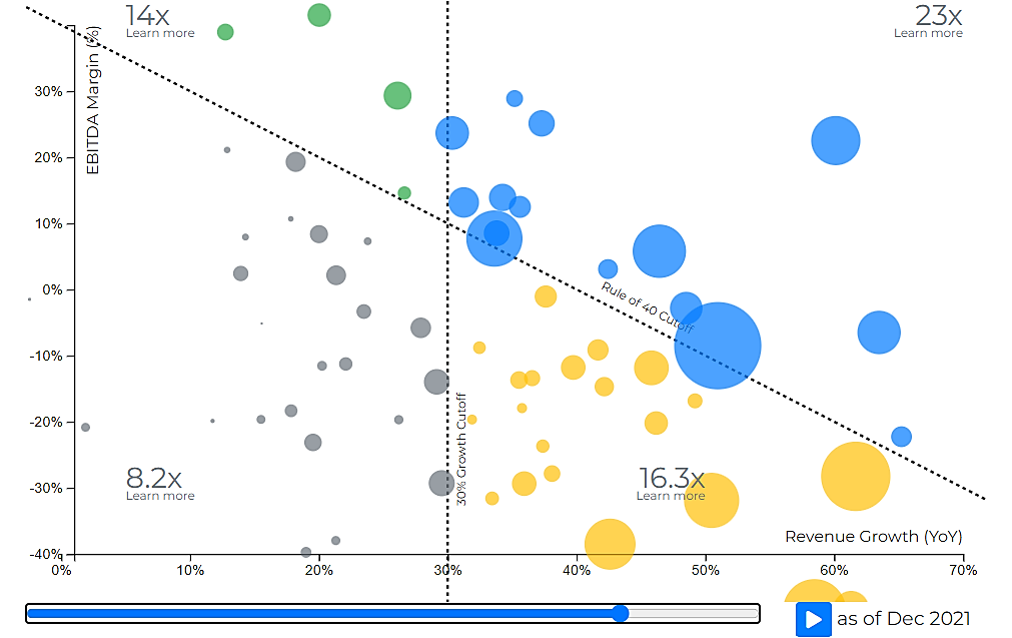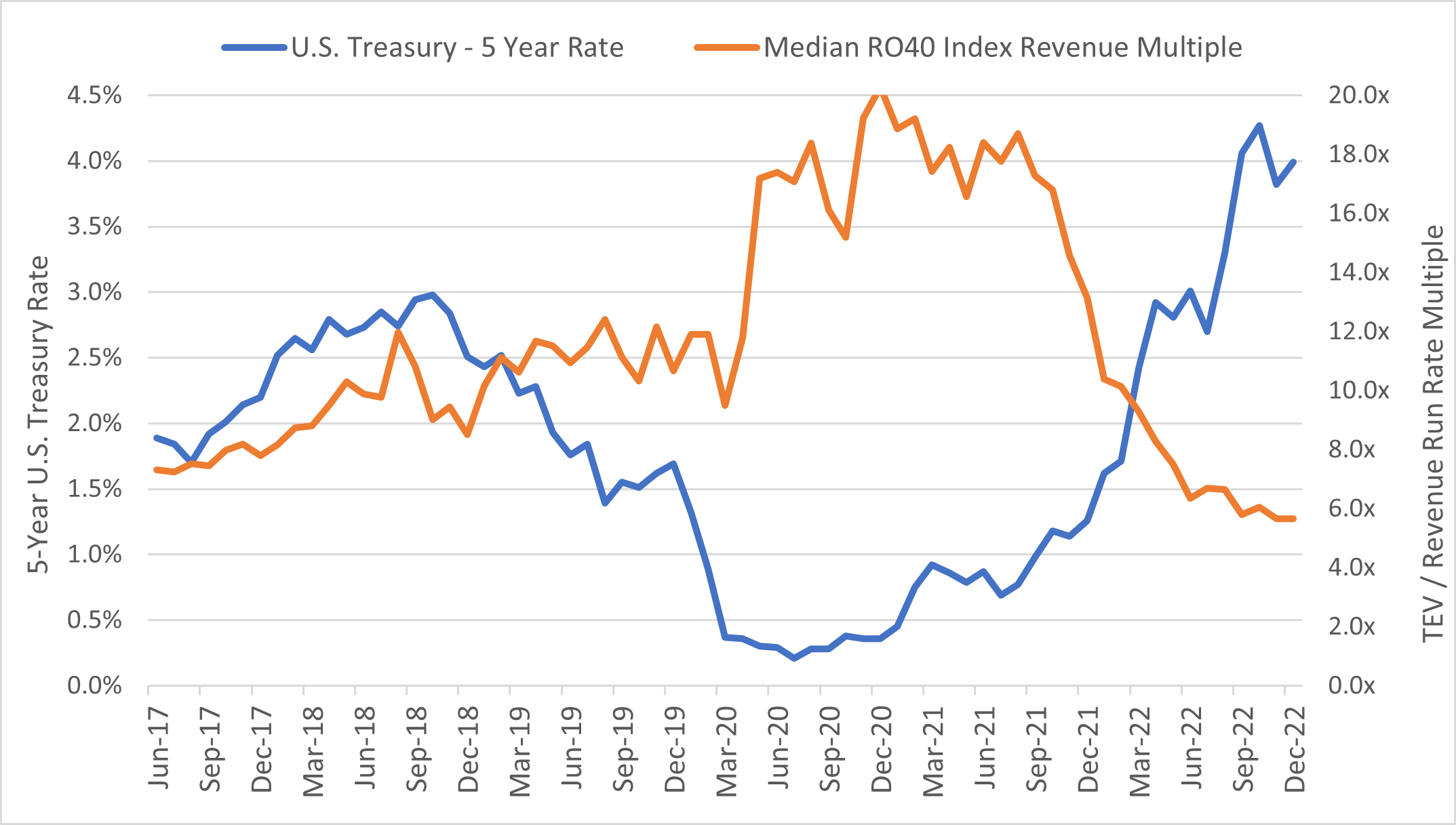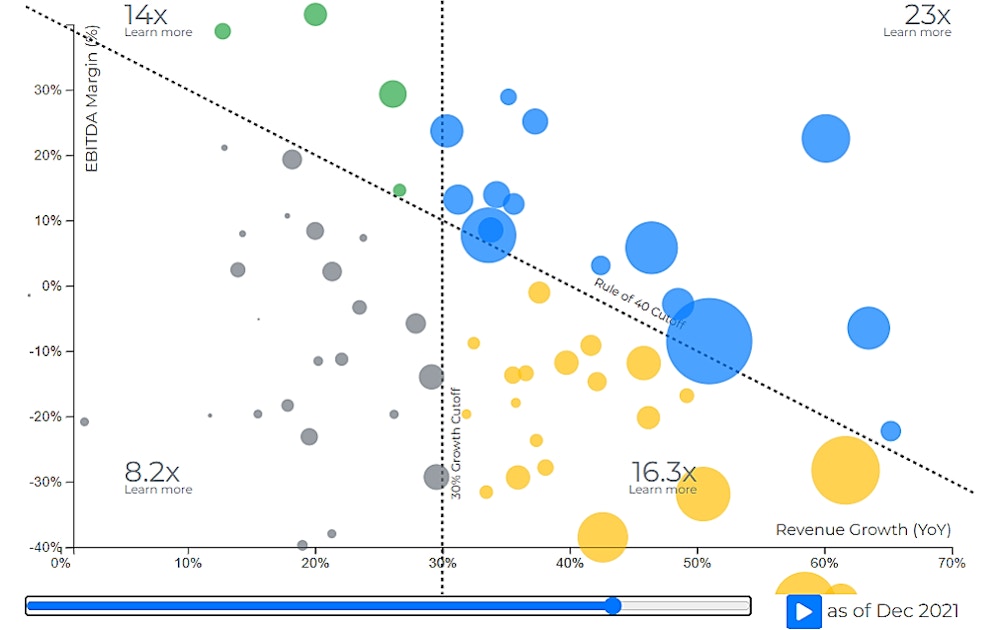The Rule of 40 is a metric used to evaluate the financial performance of software companies and is achieved if growth rate percentage plus profitability margin equals 40% or greater.
How to calculate the Rule of 40:

SaaS companies have historically been difficult to value due to guidelines on the recognition of future recurring revenue. As such, the Rule of 40 is often used by investors and analysts as a way to quickly assess the health of a software company. It’s generally viewed as a positive indicator if a company can achieve the Rule of 40, as it shows that the business is able to grow at a strong rate while maintaining a balance of profitability, growth, and capital efficiency.
It’s been a challenging year for the markets, and the world of SaaS has been no exception. Just 12 months ago, chasing growth at all costs was primarily favored in the public markets, as evidenced by the 16.3x Revenue Multiple for the high growth unprofitable subset of Volition Capital’s Rule of 40 Index.

While companies in the bottom right quadrant are generally less profitable, losses can be funded through outside capital given the ease of issuing additional debt or equity. The low interest rates in response to the COVID-19 pandemic created an environment where founders could rely on cheap debt to fund operations and invest in growth opportunities with minimal impact to profit margins.
Impact On Software Valuations
The pace and magnitude
of the Fed’s rate increases led to a significant repricing of equities in 2022.
The 5-year U.S. Treasury yield began 2022 around 1.3% and closed the year at
4.0%, representing the highest level in nearly 15 years. Higher interest rates impact
a company’s cost of issuing debt or equity, which can lead to unnecessary
dilution or an inability to raise capital for businesses that have historically
relied on outside capital to fund growth.

The SaaS model assumes that investing in growth in the early stages can position businesses to achieve profitability as they mature. Prioritizing growth over profitability can drive equity value during a bull market, but what happens amidst a market correction? There are long-term benefits to executing on the balance of growth and profitability. Companies growing < 30% that are generally profitable experienced a lower decline in revenue multiples in 2022 versus businesses that generally have prioritized growth over profitability.
Equity investors are less likely to assign a premium valuation multiple when interest rates trend higher given the value of future earnings appears less attractive in a higher rate environment. Prioritizing growth over profitability led to inflated share prices as investors shifted focus toward the potential for future earnings in 2022.
The value of a software business can be calculated as the net present value of its future cash flows. When interest rates rise, the discount rate applied to a discounted cash flow analysis (DCF) also increases, yielding a lower valuation. As illustrated above, SaaS valuations declined rapidly as interest rates on the 5-year treasury increased.

As interest rates rise, the associated interest expense increases and reduces profit margins. Businesses have several options: continue to invest in a similar capacity, at lower profitability given the increased interest expense, or reduce investments in growth initiatives to maintain a proportionate level of interest expense. Additionally, due to current business interest expense limitation rules, the higher interest rates won’t necessarily result in lower taxes.
How Can Companies Remain Recession Resistant
Investors remain focused on evaluating the impact of higher rates on both private and public company cash burn assumptions. Elevated rates can impact the amount of risk investors are willing to accept when analyzing prospective investment opportunities.
At Volition Capital, we continuously work with Portfolio Company executives to ensure the business is prepared to withstand existing and future market conditions as outlined below.
- Identify a financially oriented leader: A financially sound founder or CFO is essential. The financial leader should have experience that aligns with the complexity of the business model.
- Manage cash burn: Closely manage the expense base and proactively implement cost reduction initiatives to extend cash runway.
- Remain flexible: Balance sheet resources provide flexibility whether on offense or defense. Founders must be prepared to adapt their product or service to changing market conditions
- Budget for both the short and long-term: Balance near-term working capital dynamics with long-term operational and strategic goals.
- Diversify: Avoid customer and product concentration. Identify new sales opportunities while generating upsell on existing products or services.
Benchmark Your Company Against SaaS Competitors
We’re especially excited to allow you to get in on the action. Using our Rule of 40 Calculator, you can interactively compare your company’s Rule of 40 results to that of each of these publicly-traded SaaS companies. Simply scroll to the bottom of the page, enter in your growth and EBITDA margin, and the calculator will plot your metrics on the graph, giving you your own Rule of 40 score.
You can even filter by industry to compare yourself against a relevant set of companies. Feel free to play around with the Index as there are lots of insights that you can uncover.
Though not perfect, the Rule of 40 is a useful metric. Companies should evaluate their specific market, and capital availability, to determine if sacrificing short-term profitability in pursuit of responsible growth is the correct decision. Growth at all costs introduces financing risk and assumes that capital will remain readily available to fund continued losses.
As noted by Volition’s Larry Cheng, market conditions can change rapidly and companies are introducing material risk when they are dependent
on future financings. The best entrepreneurs will balance their business needs with the market forces around them.
